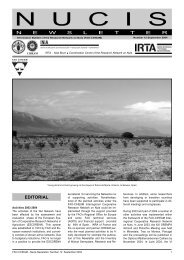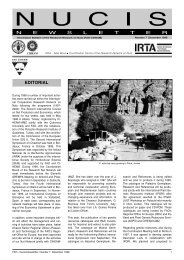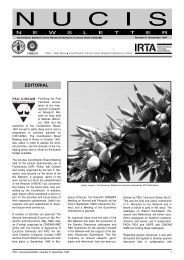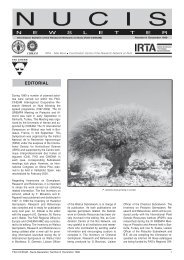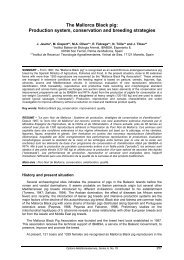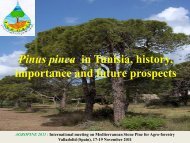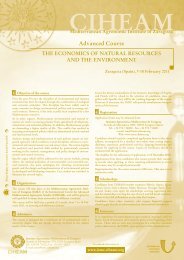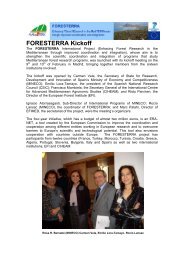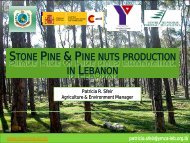NUCIS number 10. December 2001. 48 pages (full ... - IAMZ - ciheam
NUCIS number 10. December 2001. 48 pages (full ... - IAMZ - ciheam
NUCIS number 10. December 2001. 48 pages (full ... - IAMZ - ciheam
Create successful ePaper yourself
Turn your PDF publications into a flip-book with our unique Google optimized e-Paper software.
Figure 2. Proline content of stocks at the beginning of stress<br />
Figure 4. Proline content, the beginning of second stress week<br />
after weekly irrigation<br />
9<br />
15<br />
A<br />
12<br />
mg P./g f.w.<br />
6<br />
3<br />
A<br />
A<br />
A<br />
A<br />
mg P./g f.w.<br />
9<br />
6<br />
3<br />
B B B<br />
0<br />
P. khinjuk<br />
‘Sarakhs’ ‘Fandoghi’ ‘Qazvini’<br />
0<br />
P. khinjuk<br />
‘Sarakhs’ ‘Fandoghi’ ‘Qazvini’<br />
Figure 3. Proline content of stocks, end of first week of stress<br />
Figure 5. Proline content, the end of second stress week<br />
mg P./g f.w.<br />
25<br />
20<br />
15<br />
10<br />
A<br />
A<br />
A<br />
A<br />
mg P./g f.w.<br />
9<br />
6<br />
3<br />
A<br />
Proline 77/2/20<br />
A<br />
A<br />
A<br />
5<br />
0<br />
P. khinjuk<br />
‘Sarakhs’ ‘Fandoghi’ ‘Qazvini’<br />
0<br />
P. khinjuk<br />
‘Sarakhs’ ‘Fandoghi’ ‘Qazvini’<br />
MATERIALS AND METHODS<br />
The experiment was carried out on 10<br />
month old seedlings of Pistacia vera cultivars<br />
“Fandoghi”, “Sarakhs”, “Qazvini”,<br />
and P. khinjuk in a greenhouse under<br />
controlled temperature (25ºC day, 18-<br />
20 o C night), light (7000-10000 lux) and<br />
humidity (65-70%). Seeds were collected<br />
from wild and cultivated areas and after<br />
dehulling and washing with ethanol and<br />
distilled water, disinfested by rinsing in<br />
20% sodium hypochlorite solution. Then<br />
they were planted in black polyethylene<br />
bags filled with sandy loam soil.<br />
The layout was factorial experiment in a<br />
randomized complete design. Data were<br />
statistically analyzed using analysis of variance<br />
procedures by MiniTab and MSTA-<br />
TC software.<br />
Water stress was induced by water<br />
withholding (Krizek, 1985). Treatments<br />
were S1 as control (interval one-day irrigation),<br />
S2 (weekly irrigation) and S3 (permanent<br />
withholding i.e. death treatment).<br />
Sampling and proline determination<br />
Sampling was carried out at the end and<br />
the beginning of every week. Fully expanded<br />
leaves from middle part of shoots<br />
were sampled. Samples analyzed for proline<br />
using the method developed by Bates<br />
et al (Bates et al, 1973) based on data<br />
Figure 6. Significant difference in proline content of stocks at the end of stress<br />
extracted from spectrophotometric absorption<br />
determined at 520 nm. Proline<br />
concentration was calculated applying a<br />
standard curve (figure 1) on mg proline/g<br />
fresh weight basis.<br />
RESULTS<br />
The first leaf dryness symptoms were reported<br />
in “Fandoghi” during the fourth<br />
week. By the end of fourth week all S3-<br />
treated seedlings showed dryness.<br />
According to results of this experiment<br />
and other ones carried out simultaneously<br />
studying other parameters e.g. growth<br />
indices, leaf water potential and relative<br />
water content (Gholipour and Zamani,<br />
1999), P.khinjuk and “Fandoghi” has<br />
been introduced as the most resistant<br />
and sensitive rootstocks, respectively.<br />
mg P./g f.w.<br />
45<br />
40<br />
35<br />
30<br />
25<br />
20<br />
15<br />
10<br />
5<br />
0<br />
khi.<br />
‘Sar.’<br />
‘Qaz.’<br />
‘Fan.’<br />
S1<br />
S2<br />
S3<br />
Rootstocks and proline content<br />
No statistically significant difference<br />
among rootstocks leaf proline content<br />
was reported at the beginning and at the<br />
end of the first week of stress period (fig.<br />
2,3). After first irrigation of S2-treated and<br />
S1-treated seedlings, proline content of<br />
three rootstocks decreased, but proline<br />
content of P.khinjuk remained high (fig.<br />
4). At the end of the second week, proline<br />
content of P.Khinjuk decreased (from<br />
about 5.5 mM to 2.5 mM) but other rootstocks<br />
showed an increased proline content<br />
up to about 5-mM (fig. 5). By the end<br />
of stress period proline content fluctuation<br />
was almost similar to the first two<br />
32 FAO-CIHEAM - Nucis-Newsletter, Number 10 <strong>December</strong> 2001



